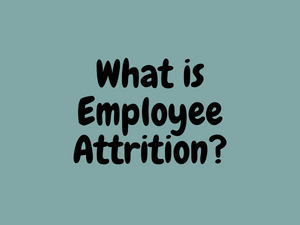If an employee leaves your company for voluntary or involuntary reasons and you do not refill their position, “employee attrition” has taken place.
Voluntary vs. involuntary attrition
According to an article published by AIHR Digital, employee attrition can be voluntary or involuntary.
For example, voluntary attrition happens when the employee leaves for these reasons:
- Retirement.
- Relocation or moving away.
- Returning to school full time.
- Family obligations.
- Health issues.
- Accepting a new job.
- Undisclosed or personal reasons.
Some examples of involuntary attrition are:
- Downsizing, layoffs, financial setbacks or organizational restructuring.
- Termination for poor performance.
- Death of an employee.
Although employee attrition might sound exactly like employee turnover, there are subtle differences between them.
Employee attrition vs. employee turnover
Both attrition and turnover refer to employee departure. However, attrition means that the position stays vacant after the employee has voluntarily or involuntarily left. A high attrition rate means that the organization is diminishing because vacant positions are not refilled.
Turnover, on the other hand, includes only positions that are refilled after the employee leaves. Though a high turnover rate is often a negative indicator in retention, it’s not uncommon for certain businesses to have high turnover and continue to grow because they hire more people than they lose. This is common in industries like retail.
Oftentimes, turnover happens suddenly and disruptively — such as employees quitting because of a hostile work environment or dissatisfaction with their pay. Because these positions must be refilled, typically within a short period of time, turnover is typically costly. According to an article published by Gallup, “The cost of replacing an individual employee can range from one-half to two times the employee’s annual salary — and that’s a conservative estimate.” High turnover can give the impression that the employer has trouble retaining good workers.
Attrition tends to be more amicable, as it normally stems from employees leaving because their job has come to a natural end (e.g., retirement) or because of unavoidable employer circumstances (e.g., downsizing or layoff).
On the upside, employee attrition can help you decrease labor costs. On the downside, it reduces the size and strength of your workforce and may require remaining employees to take on more work — which can effectively lead to high turnover.
Measuring employee attrition
As explained in an article published by the Society for Human Resources Management, it’s not enough to just track employee turnover. Employers should also use attrition metrics to “determine the extent to which they might be losing their most valuable employees and those in positions critical to their company’s future.”
To determine your attrition rate, divide the number of employees who have left the company without being replaced in a given period by the average number of employees in the same period. Multiply the result by 100 to get the attrition percentage. Then consider your situation, and make any HR and payroll adjustments accordingly.